Complex sentences
We talked about compound sentences such as:
1. Beth said hello to her mother’s friend and then she walked outside.
Each of the sentences (clauses) that is part of the compound sentence plays an equal role in the sentence; one clause is not superior to or more important than the other, in terms of the structure of the sentence.
2. Harry was only fifteen when his mother sent him away to school.
3. Mr. Edwards looked her straight in the eye although he wasn’t really sincere.
4. I won’t tell you the answer unless you agree to help.
Sentences 2-4 also each contain two sentences, or clauses, which are combined to make a larger sentence. However, one of these sentences is more important than the other. The more important sentence is called the main clause, or independent clause; the less important sentence, the one that is a subpart of the main clause, is called the dependent clause or subordinate clause. Each clause, whether it’s a main clause or subordinate clause, has its own subject and verb phrase. Sentences that contain a main clause and at least one dependent clause are called complex sentences.
The main clause of each of the following sentences is in bold; the dependent clause is underlined:
5. Harry was only fifteen when his mother sent him away to school.
6. Mr. Edwards looked her straight in the eye although he wasn’t really sincere.
7. I won’t tell you the answer unless you agree to help.
Quick tip
A complex sentence consists of at least two sentences (clauses): a main clause and a dependent clause. The dependent clause is a subpart of the main clause and adds information to it. Example, with the dependent clause underlined: Sally visited her before she moved.
Recall that, in a compound sentence, the clauses are joined by a coordinating conjunction such as and, or, and but. In a complex sentence, the dependent clause is joined to the rest of the sentence by a subordinating conjunction. The common subordinating conjunctions of English are repeated here for reference.
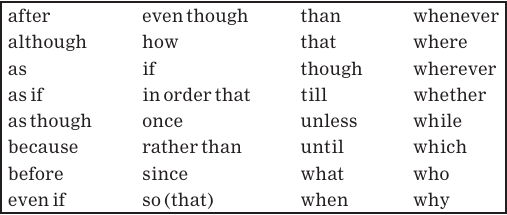
Quick tip
A dependent clause is joined to another clause by a subordinating conjunction such as although, if, where.
Quick tip
The easiest way to identify a dependent clause is to look for a subordinating conjunction and see if it’s followed by a sentence. If it is, then the subordinating conjunction plus the sentence directly following it is a dependent clause.
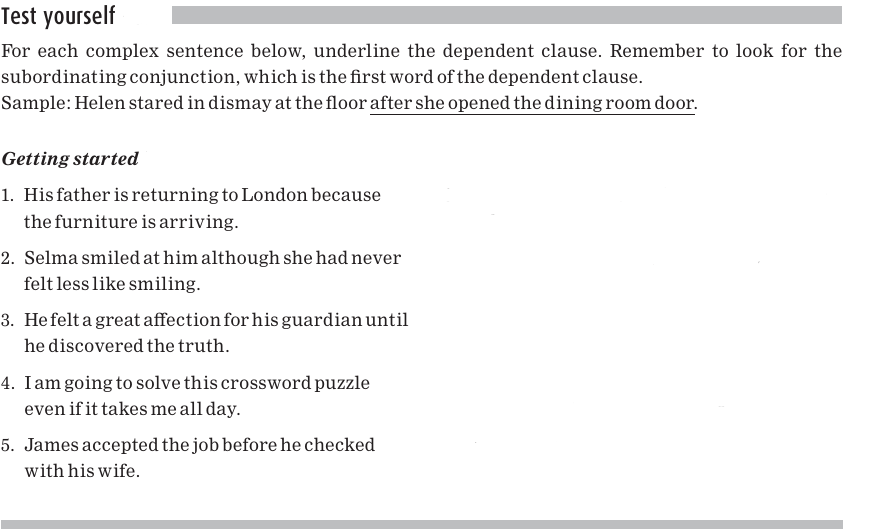
Answers

In the complex sentences we’ve looked at so far, the dependent clause follows the main clause. But sometimes the dependent clause comes before the main clause. In these next examples of complex sentences, the dependent clauses are underlined:
8. After he uttered her name, an awful silence fell on the room.
9. While we hurried to the restaurant, the rain continued to pour.
10. Even though she was a difficult woman, they had a good marriage.
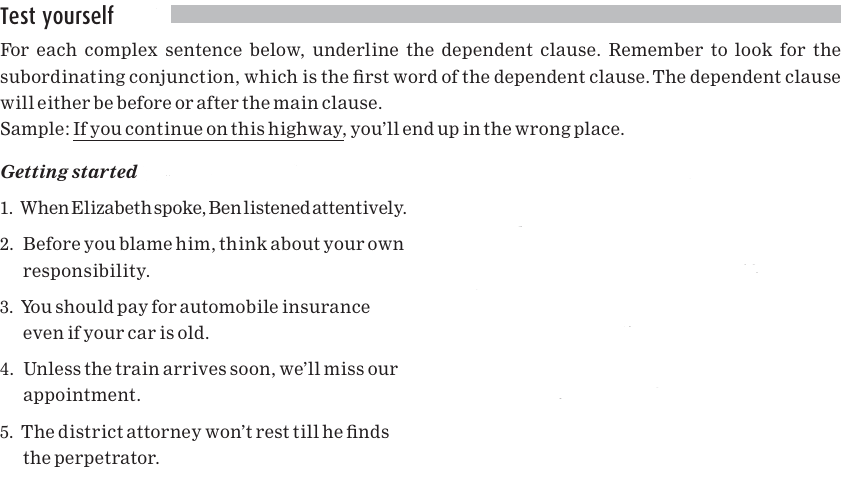
Answers


Answers

A complex sentence contains only one main clause, but it can contain more than one dependent clause. In the following examples, there is a main clause and two dependent clauses. The main clause is again in bold; the dependent clauses are underlined. Notice that we sometimes have flexibility in terms of the placement of each of the clauses.
11a. Harry was only fifteen when his mother sent him away to school, although he looked much older.
11b. When his mother sent him away to school, Harry was only fifteen, although he looked much older.
11c. Although he looked much older when his mother sent him away to school, Harry was only fifteen.
12a. I won’t tell you the answer unless you agree to help, because this issue is confidential.
12b. Unless you agree to help, I won’t tell you the answer, because this issue is confidential.
12c. Because this issue is confidential, unless you agree to help, I won’t tell you the answer.
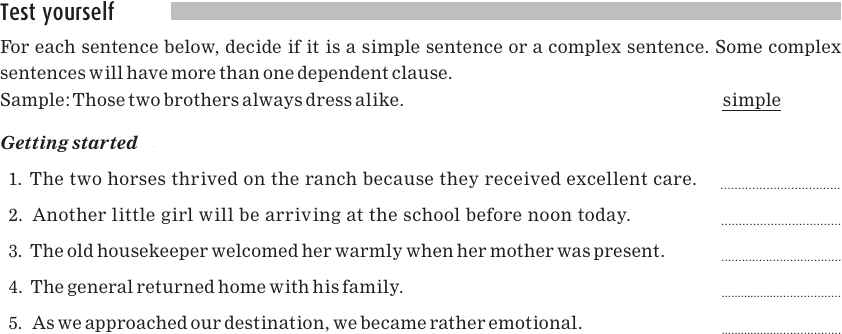
Answers

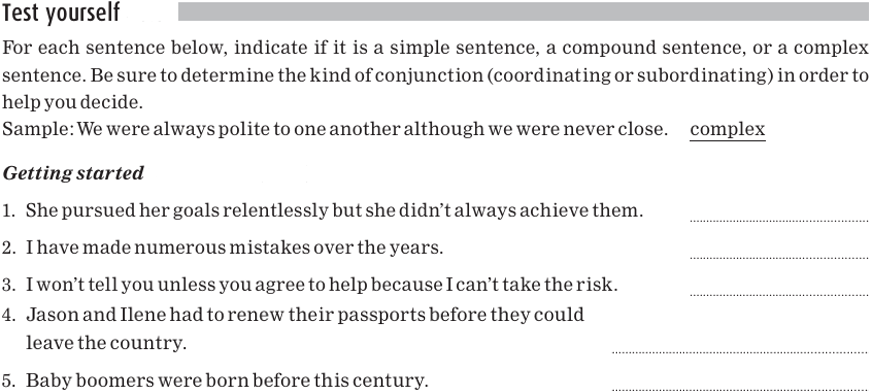
Answers

The ones we’ve talked about so far are called adverbial clauses because, like adverbs, they typically tell us more about a verb, adjective, or another adverb. For example, in the sentence, Things improved after Mr. Eliot arrived, the underlined dependent clause is telling us something about the time of the action.
In other complex sentences, dependent clauses can be used as noun phrases. Take a look at the following pair of sentences:
13a. That statement is silly.
13b. What Mark just said is silly.
Insentence13a, that statement is a noun phrase. In sentence 13b, what Mark just said isa dependent clause which is functioning as a noun phrase of the main sentence. When a dependent clause is functioning as a noun phrase, it’s called a noun clause. Here are some more sentence pairs in which the second sentence of the pair has a dependent clause (underlined) acting as a noun phrase.
14a. I know the truth. Simple sentence
14b. I know that you’re right. Complex sentence
15a. It remains unknown. Simple sentence
15b. Why they left town remains unknown. Complex sentence
Notice that noun clauses look just like other dependent clauses: they begin with a subordinating conjunction and contain both a subject and a verb phrase. However, when a sentence has a noun clause, the rest of the sentence cannot always stand alone; it needs the noun clause to be complete. For example, in sentence 15b, remains unknown is not a complete sentence.
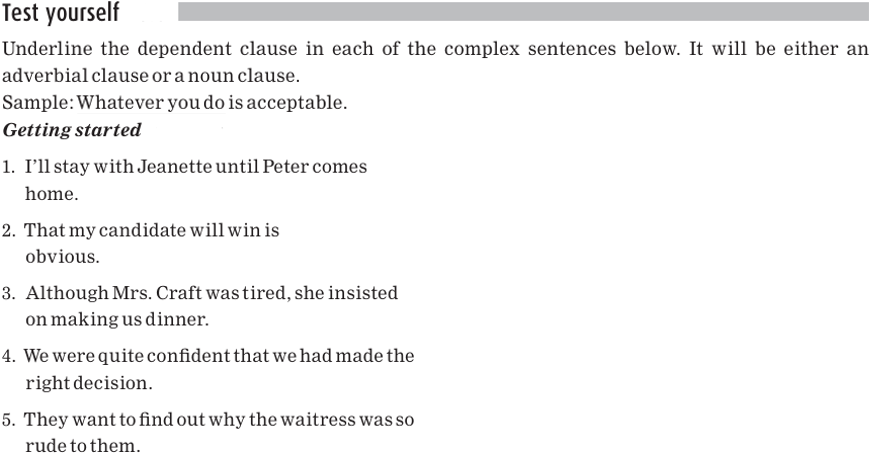
Answers

We’ve been telling you to look for the subordinating conjunction to help you find the dependent clause. But what about these next sentences (with the dependent clauses underlined)?
16a. I know that you’re right.
16b. I know you’re right.
17a. You believed that the defendant was innocent.
17b. You believed the defendant was innocent.
As you can see, we can delete the subordinating conjunction that in a noun clause when the dependent clause follows the main clause. However, if the dependent clause comes before the main clause, the subordinating conjunction that cannot be deleted:
18a. That her daughter is talented has been obvious for years.
18b. *Her daughter is talented has been obvious for years.
19a. That the defendant was innocent became clear during the trial.
19b. *The defendant was innocent became clear during the trial.
Quick tip
In a noun clause, the subordinating conjunction that can be deleted following a main clause. Example: I think (that) it’s going to rain.
So when you don’t see a subordinating conjunction in a sentence, but the sentence has more than one subject and verb phrase, ask yourself if you can insert that somewhere. If so, then you’ll know you have a dependent clause.
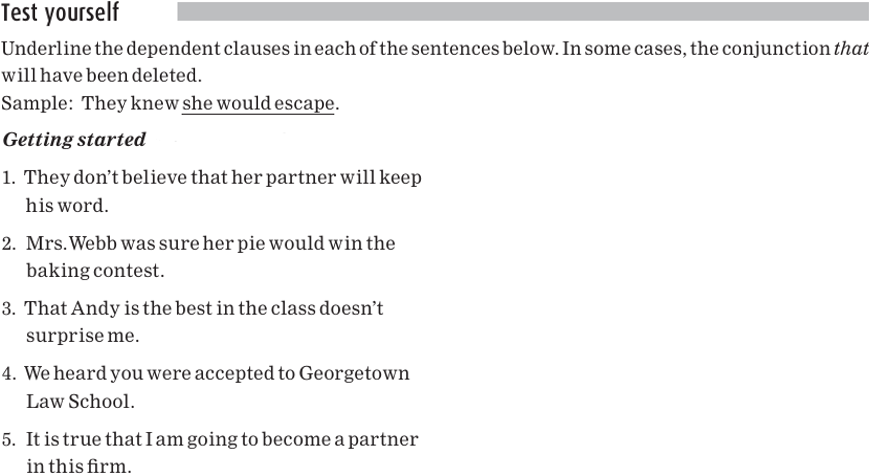
Answers

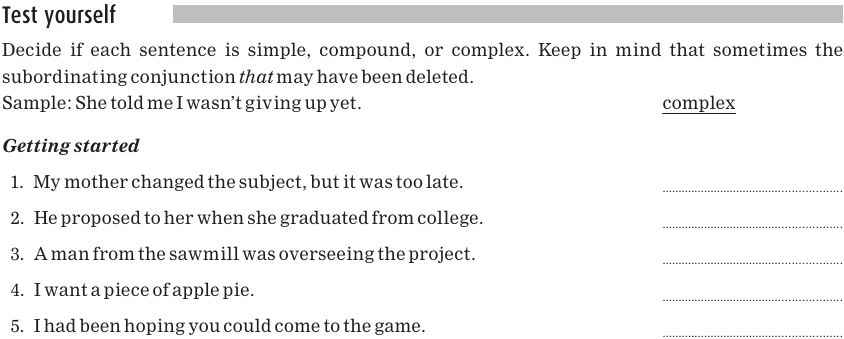
Answers

There’s another very common type of subordinating clause, called a relative clause. Here are some examples:
20. I’ll tell my husband, who will be home soon.
21. The person who knows her best is Richard.
22. Miss Livingston had her money in the bank that failed.
Since there’s quite a bit to say about relative clauses, we ‘ve given them their own lesson.
 الاكثر قراءة في Grammar
الاكثر قراءة في Grammar
 اخر الاخبار
اخر الاخبار
اخبار العتبة العباسية المقدسة


